University Report: Strategy, Management & Acquisition of IS/IT
VerifiedAdded on 2023/01/24
|5
|1105
|32
Report
AI Summary
This report delves into the strategic use of Information Systems (IS) and Information Technology (IT), examining key drivers such as technological advancements and their impact on innovation, privacy, and connectivity. It identifies inhibitors to IS/IT adoption, including financial constraints and lack of internal IT expertise, particularly within SMEs. The report highlights emerging technologies like 3D in movies and gene therapy, and explores the challenges and issues faced by public sector organizations and SMEs in managing IS/IT, including regulatory restrictions and the need for societal engagement. It further discusses strategic IS/IT use, the importance of policy frameworks, and challenges related to workforce changes and service quality, providing insights into e-government initiatives and the application of theoretical frameworks in the public sector.
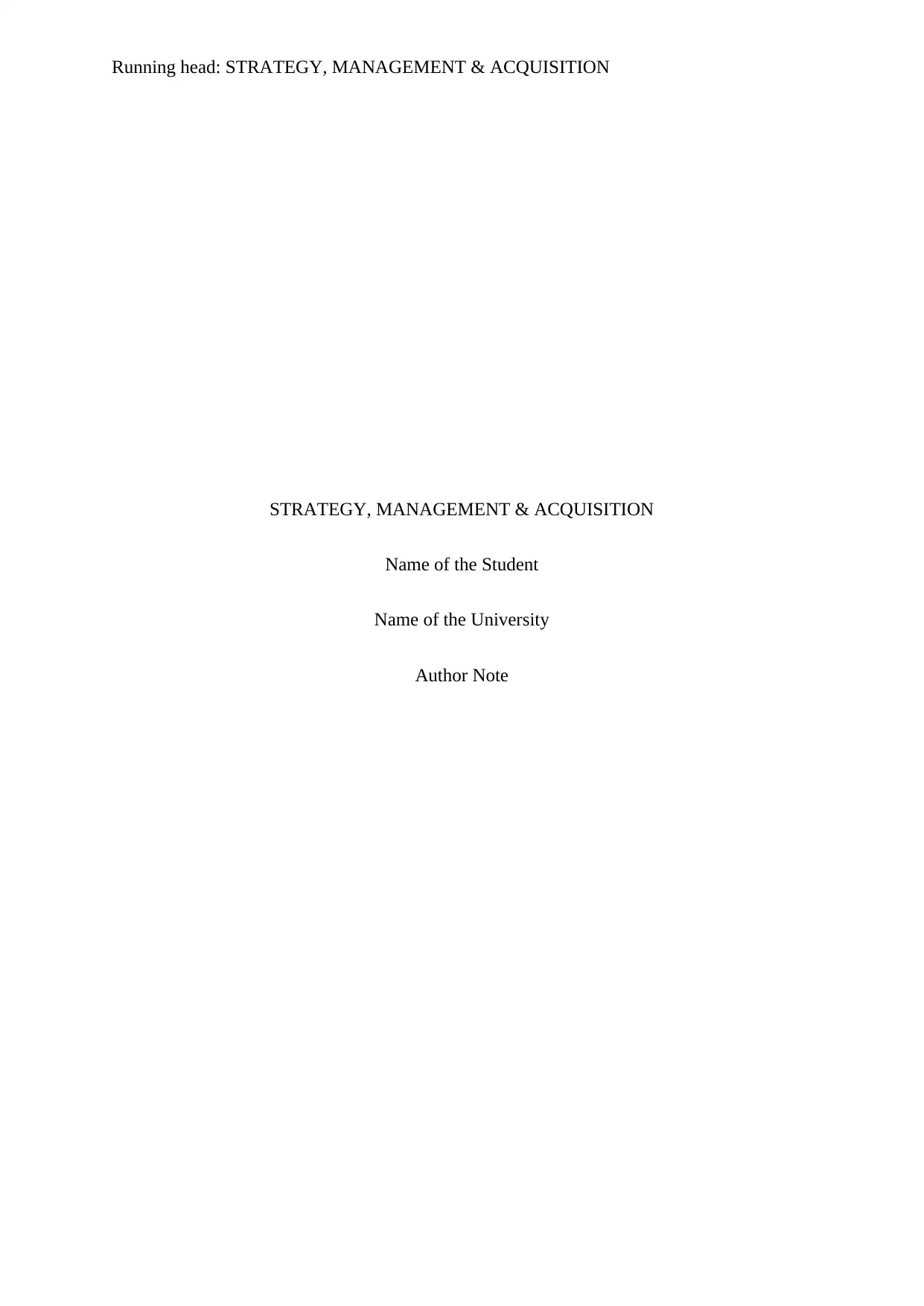
Running head: STRATEGY, MANAGEMENT & ACQUISITION
STRATEGY, MANAGEMENT & ACQUISITION
Name of the Student
Name of the University
Author Note
STRATEGY, MANAGEMENT & ACQUISITION
Name of the Student
Name of the University
Author Note
Paraphrase This Document
Need a fresh take? Get an instant paraphrase of this document with our AI Paraphraser
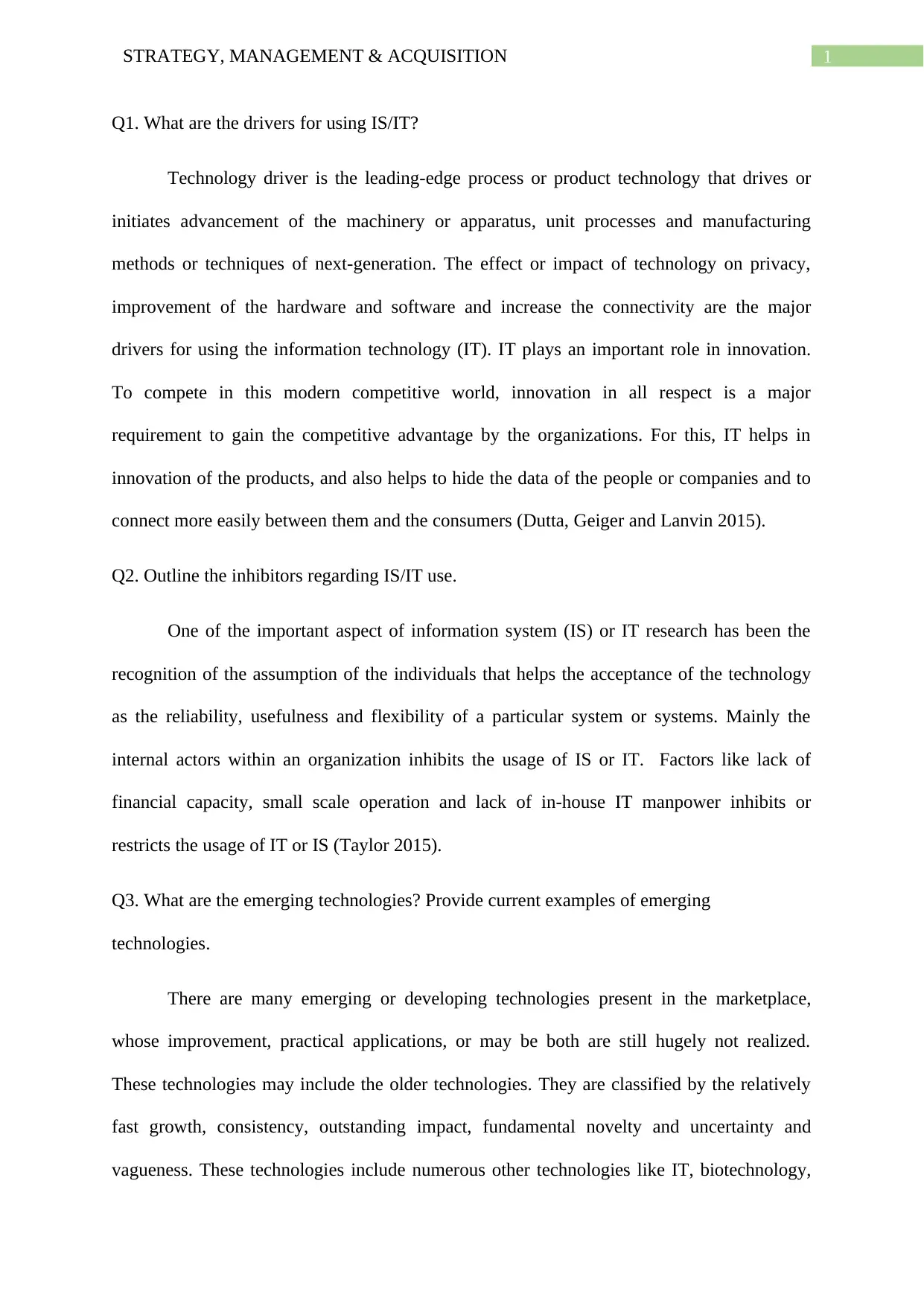
1STRATEGY, MANAGEMENT & ACQUISITION
Q1. What are the drivers for using IS/IT?
Technology driver is the leading-edge process or product technology that drives or
initiates advancement of the machinery or apparatus, unit processes and manufacturing
methods or techniques of next-generation. The effect or impact of technology on privacy,
improvement of the hardware and software and increase the connectivity are the major
drivers for using the information technology (IT). IT plays an important role in innovation.
To compete in this modern competitive world, innovation in all respect is a major
requirement to gain the competitive advantage by the organizations. For this, IT helps in
innovation of the products, and also helps to hide the data of the people or companies and to
connect more easily between them and the consumers (Dutta, Geiger and Lanvin 2015).
Q2. Outline the inhibitors regarding IS/IT use.
One of the important aspect of information system (IS) or IT research has been the
recognition of the assumption of the individuals that helps the acceptance of the technology
as the reliability, usefulness and flexibility of a particular system or systems. Mainly the
internal actors within an organization inhibits the usage of IS or IT. Factors like lack of
financial capacity, small scale operation and lack of in-house IT manpower inhibits or
restricts the usage of IT or IS (Taylor 2015).
Q3. What are the emerging technologies? Provide current examples of emerging
technologies.
There are many emerging or developing technologies present in the marketplace,
whose improvement, practical applications, or may be both are still hugely not realized.
These technologies may include the older technologies. They are classified by the relatively
fast growth, consistency, outstanding impact, fundamental novelty and uncertainty and
vagueness. These technologies include numerous other technologies like IT, biotechnology,
Q1. What are the drivers for using IS/IT?
Technology driver is the leading-edge process or product technology that drives or
initiates advancement of the machinery or apparatus, unit processes and manufacturing
methods or techniques of next-generation. The effect or impact of technology on privacy,
improvement of the hardware and software and increase the connectivity are the major
drivers for using the information technology (IT). IT plays an important role in innovation.
To compete in this modern competitive world, innovation in all respect is a major
requirement to gain the competitive advantage by the organizations. For this, IT helps in
innovation of the products, and also helps to hide the data of the people or companies and to
connect more easily between them and the consumers (Dutta, Geiger and Lanvin 2015).
Q2. Outline the inhibitors regarding IS/IT use.
One of the important aspect of information system (IS) or IT research has been the
recognition of the assumption of the individuals that helps the acceptance of the technology
as the reliability, usefulness and flexibility of a particular system or systems. Mainly the
internal actors within an organization inhibits the usage of IS or IT. Factors like lack of
financial capacity, small scale operation and lack of in-house IT manpower inhibits or
restricts the usage of IT or IS (Taylor 2015).
Q3. What are the emerging technologies? Provide current examples of emerging
technologies.
There are many emerging or developing technologies present in the marketplace,
whose improvement, practical applications, or may be both are still hugely not realized.
These technologies may include the older technologies. They are classified by the relatively
fast growth, consistency, outstanding impact, fundamental novelty and uncertainty and
vagueness. These technologies include numerous other technologies like IT, biotechnology,
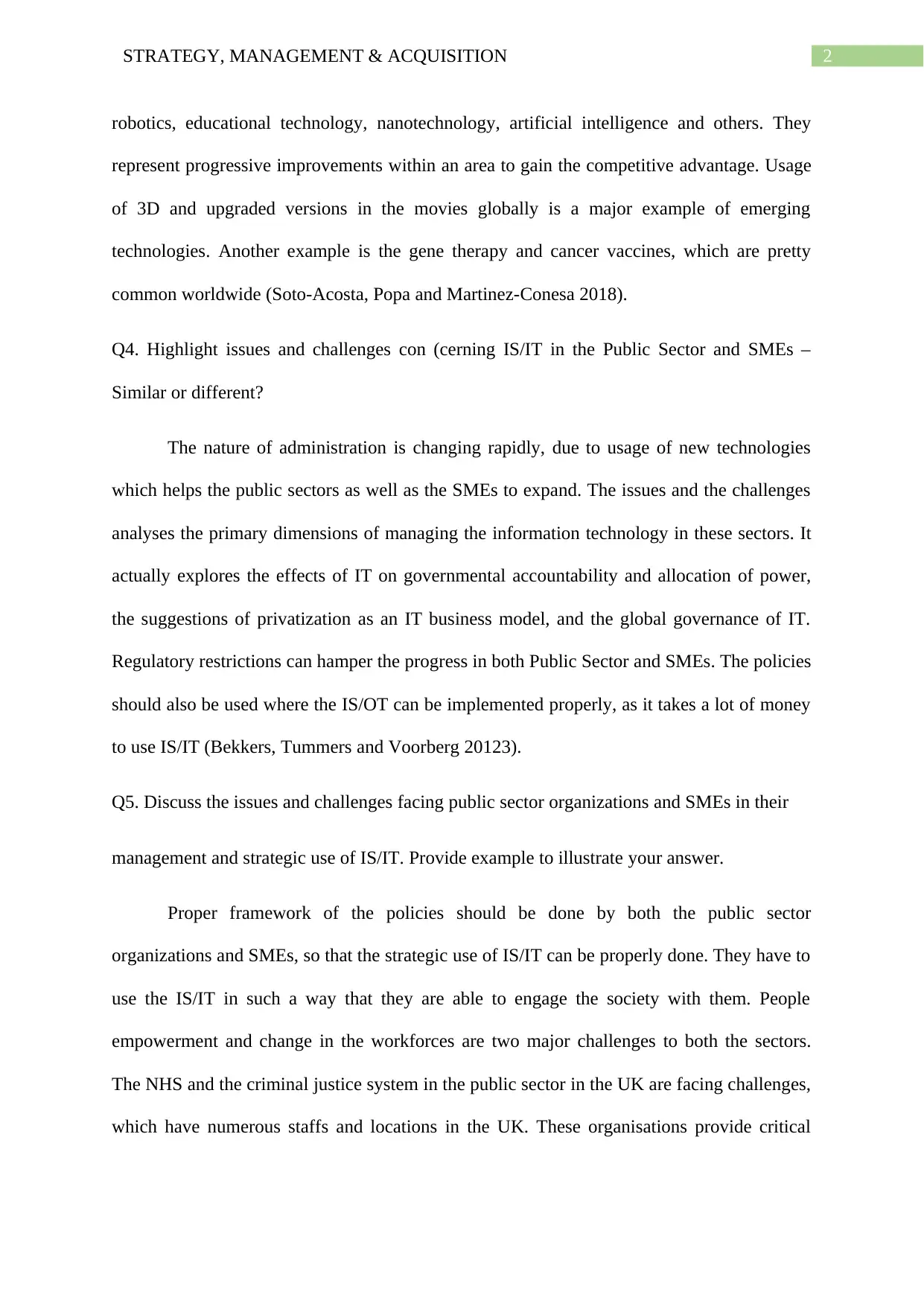
2STRATEGY, MANAGEMENT & ACQUISITION
robotics, educational technology, nanotechnology, artificial intelligence and others. They
represent progressive improvements within an area to gain the competitive advantage. Usage
of 3D and upgraded versions in the movies globally is a major example of emerging
technologies. Another example is the gene therapy and cancer vaccines, which are pretty
common worldwide (Soto-Acosta, Popa and Martinez-Conesa 2018).
Q4. Highlight issues and challenges con (cerning IS/IT in the Public Sector and SMEs –
Similar or different?
The nature of administration is changing rapidly, due to usage of new technologies
which helps the public sectors as well as the SMEs to expand. The issues and the challenges
analyses the primary dimensions of managing the information technology in these sectors. It
actually explores the effects of IT on governmental accountability and allocation of power,
the suggestions of privatization as an IT business model, and the global governance of IT.
Regulatory restrictions can hamper the progress in both Public Sector and SMEs. The policies
should also be used where the IS/OT can be implemented properly, as it takes a lot of money
to use IS/IT (Bekkers, Tummers and Voorberg 20123).
Q5. Discuss the issues and challenges facing public sector organizations and SMEs in their
management and strategic use of IS/IT. Provide example to illustrate your answer.
Proper framework of the policies should be done by both the public sector
organizations and SMEs, so that the strategic use of IS/IT can be properly done. They have to
use the IS/IT in such a way that they are able to engage the society with them. People
empowerment and change in the workforces are two major challenges to both the sectors.
The NHS and the criminal justice system in the public sector in the UK are facing challenges,
which have numerous staffs and locations in the UK. These organisations provide critical
robotics, educational technology, nanotechnology, artificial intelligence and others. They
represent progressive improvements within an area to gain the competitive advantage. Usage
of 3D and upgraded versions in the movies globally is a major example of emerging
technologies. Another example is the gene therapy and cancer vaccines, which are pretty
common worldwide (Soto-Acosta, Popa and Martinez-Conesa 2018).
Q4. Highlight issues and challenges con (cerning IS/IT in the Public Sector and SMEs –
Similar or different?
The nature of administration is changing rapidly, due to usage of new technologies
which helps the public sectors as well as the SMEs to expand. The issues and the challenges
analyses the primary dimensions of managing the information technology in these sectors. It
actually explores the effects of IT on governmental accountability and allocation of power,
the suggestions of privatization as an IT business model, and the global governance of IT.
Regulatory restrictions can hamper the progress in both Public Sector and SMEs. The policies
should also be used where the IS/OT can be implemented properly, as it takes a lot of money
to use IS/IT (Bekkers, Tummers and Voorberg 20123).
Q5. Discuss the issues and challenges facing public sector organizations and SMEs in their
management and strategic use of IS/IT. Provide example to illustrate your answer.
Proper framework of the policies should be done by both the public sector
organizations and SMEs, so that the strategic use of IS/IT can be properly done. They have to
use the IS/IT in such a way that they are able to engage the society with them. People
empowerment and change in the workforces are two major challenges to both the sectors.
The NHS and the criminal justice system in the public sector in the UK are facing challenges,
which have numerous staffs and locations in the UK. These organisations provide critical
⊘ This is a preview!⊘
Do you want full access?
Subscribe today to unlock all pages.

Trusted by 1+ million students worldwide
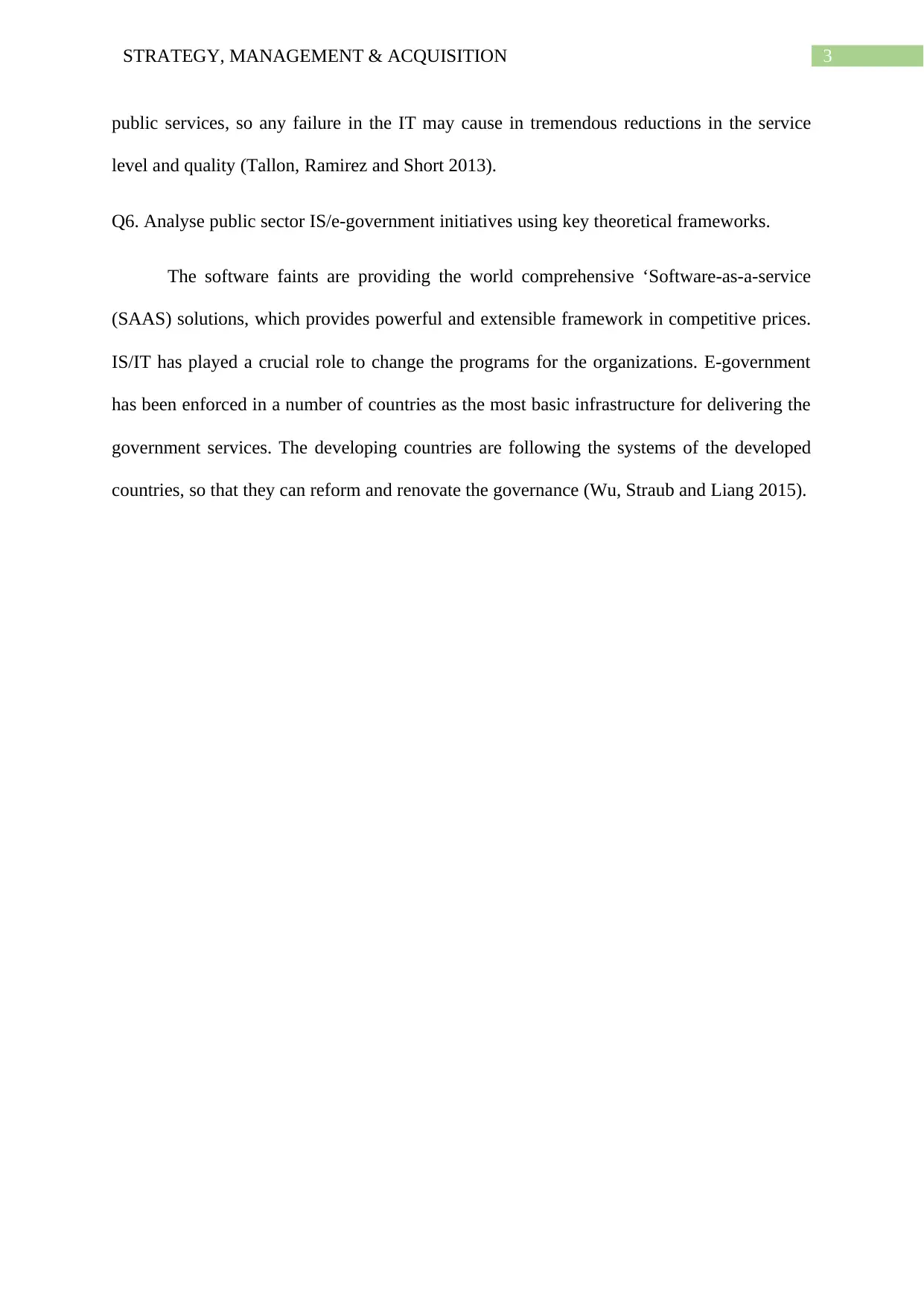
3STRATEGY, MANAGEMENT & ACQUISITION
public services, so any failure in the IT may cause in tremendous reductions in the service
level and quality (Tallon, Ramirez and Short 2013).
Q6. Analyse public sector IS/e-government initiatives using key theoretical frameworks.
The software faints are providing the world comprehensive ‘Software-as-a-service
(SAAS) solutions, which provides powerful and extensible framework in competitive prices.
IS/IT has played a crucial role to change the programs for the organizations. E-government
has been enforced in a number of countries as the most basic infrastructure for delivering the
government services. The developing countries are following the systems of the developed
countries, so that they can reform and renovate the governance (Wu, Straub and Liang 2015).
public services, so any failure in the IT may cause in tremendous reductions in the service
level and quality (Tallon, Ramirez and Short 2013).
Q6. Analyse public sector IS/e-government initiatives using key theoretical frameworks.
The software faints are providing the world comprehensive ‘Software-as-a-service
(SAAS) solutions, which provides powerful and extensible framework in competitive prices.
IS/IT has played a crucial role to change the programs for the organizations. E-government
has been enforced in a number of countries as the most basic infrastructure for delivering the
government services. The developing countries are following the systems of the developed
countries, so that they can reform and renovate the governance (Wu, Straub and Liang 2015).
Paraphrase This Document
Need a fresh take? Get an instant paraphrase of this document with our AI Paraphraser
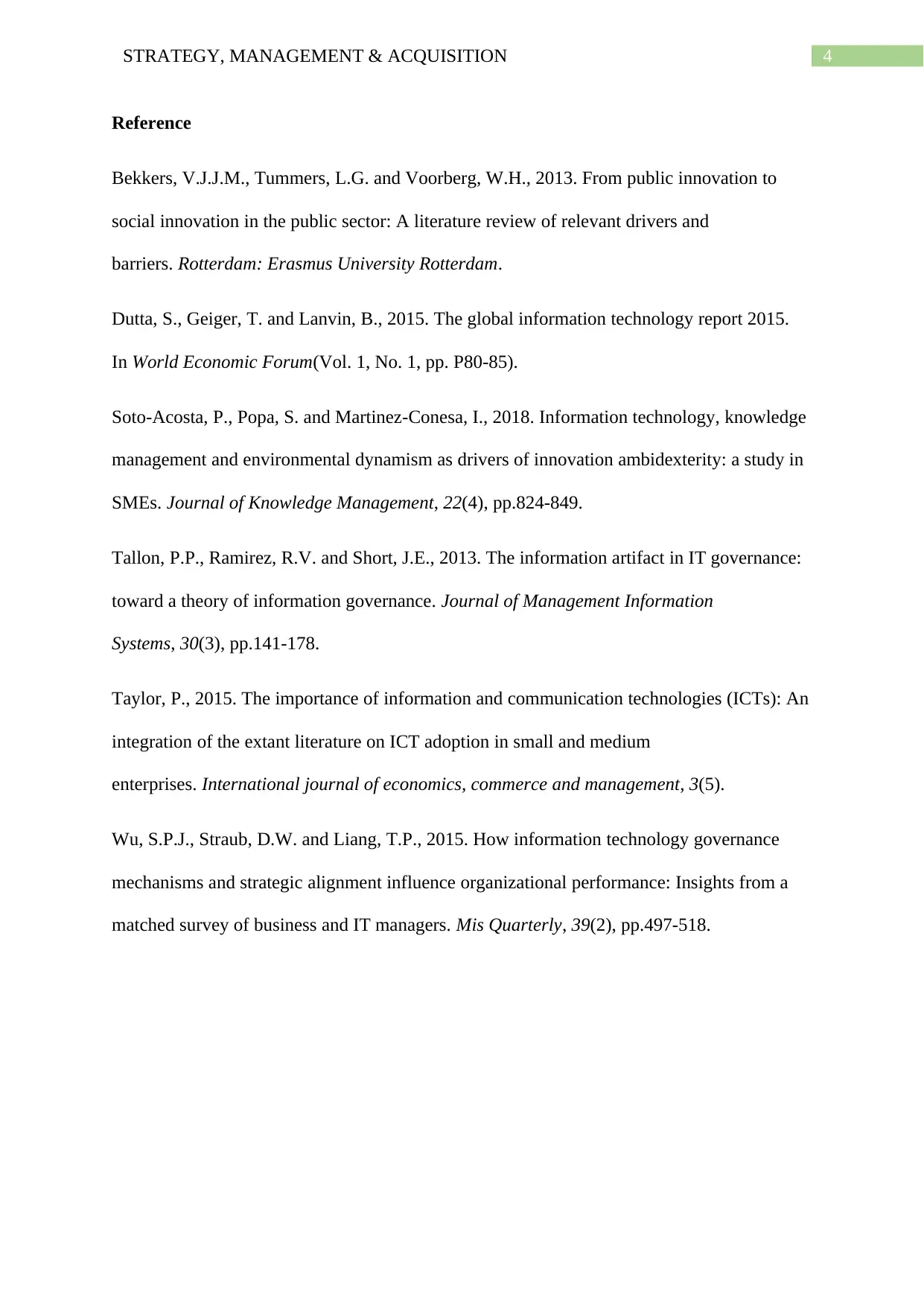
4STRATEGY, MANAGEMENT & ACQUISITION
Reference
Bekkers, V.J.J.M., Tummers, L.G. and Voorberg, W.H., 2013. From public innovation to
social innovation in the public sector: A literature review of relevant drivers and
barriers. Rotterdam: Erasmus University Rotterdam.
Dutta, S., Geiger, T. and Lanvin, B., 2015. The global information technology report 2015.
In World Economic Forum(Vol. 1, No. 1, pp. P80-85).
Soto-Acosta, P., Popa, S. and Martinez-Conesa, I., 2018. Information technology, knowledge
management and environmental dynamism as drivers of innovation ambidexterity: a study in
SMEs. Journal of Knowledge Management, 22(4), pp.824-849.
Tallon, P.P., Ramirez, R.V. and Short, J.E., 2013. The information artifact in IT governance:
toward a theory of information governance. Journal of Management Information
Systems, 30(3), pp.141-178.
Taylor, P., 2015. The importance of information and communication technologies (ICTs): An
integration of the extant literature on ICT adoption in small and medium
enterprises. International journal of economics, commerce and management, 3(5).
Wu, S.P.J., Straub, D.W. and Liang, T.P., 2015. How information technology governance
mechanisms and strategic alignment influence organizational performance: Insights from a
matched survey of business and IT managers. Mis Quarterly, 39(2), pp.497-518.
Reference
Bekkers, V.J.J.M., Tummers, L.G. and Voorberg, W.H., 2013. From public innovation to
social innovation in the public sector: A literature review of relevant drivers and
barriers. Rotterdam: Erasmus University Rotterdam.
Dutta, S., Geiger, T. and Lanvin, B., 2015. The global information technology report 2015.
In World Economic Forum(Vol. 1, No. 1, pp. P80-85).
Soto-Acosta, P., Popa, S. and Martinez-Conesa, I., 2018. Information technology, knowledge
management and environmental dynamism as drivers of innovation ambidexterity: a study in
SMEs. Journal of Knowledge Management, 22(4), pp.824-849.
Tallon, P.P., Ramirez, R.V. and Short, J.E., 2013. The information artifact in IT governance:
toward a theory of information governance. Journal of Management Information
Systems, 30(3), pp.141-178.
Taylor, P., 2015. The importance of information and communication technologies (ICTs): An
integration of the extant literature on ICT adoption in small and medium
enterprises. International journal of economics, commerce and management, 3(5).
Wu, S.P.J., Straub, D.W. and Liang, T.P., 2015. How information technology governance
mechanisms and strategic alignment influence organizational performance: Insights from a
matched survey of business and IT managers. Mis Quarterly, 39(2), pp.497-518.
1 out of 5
Related Documents
Your All-in-One AI-Powered Toolkit for Academic Success.
+13062052269
info@desklib.com
Available 24*7 on WhatsApp / Email
![[object Object]](/_next/static/media/star-bottom.7253800d.svg)
Unlock your academic potential
Copyright © 2020–2025 A2Z Services. All Rights Reserved. Developed and managed by ZUCOL.





